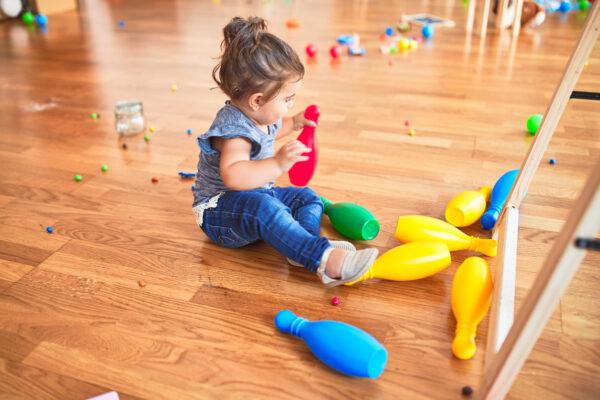Which Toys Are Best For Toddlers?
As baby gets older, their skills are developing! By the time they turn 1 they’re crawling, possibly walking, and even starting to say words. These skills all develop with the help of playtime. Check out these toys for toddlers that can help with sensory, motor and communication skills!
Which toys are best for playtime?
First, a couple things to consider:
Is the toy open-ended or close-ended?

Close-ended means there is a beginning and end to playing with this toy. Some examples include a puzzle, a book, or any game with a goal. These can be good for helping children pay attention and learn how to work toward a goal.
An open-ended toy can be played in different ways with no definite end. Examples include blocks, mirrors and dolls. This can help with pretend play and language usage.
Watch to learn more about open-ended and close-ended toys:
Which skills should toddler toys help develop?
During the toddler years, it’s best if toys help with one of the following:
Problem-solving
Pretend play and imagination
Fine motor and visual motor development
What are the best toys to help a toddler’s development?
Here are some of our recommendations!

Toys that imitate real life things.
These help with learning and life skills! As their executive function skills begin to develop, it’s great for toddlers to get experience in settings that are like real life! They’ll also have fun doing what they see their parents do. Some real life imitation toys for toddlers include kitchen and food play set, play tools, dollhouses, animal farm sets, and play doctor kits.

Push and pull toys.
As your little one learns to move independently and improve their motor skills, these toys for toddlers encourage movement and walking. Push and pull toys include carts, wagons, and pretend lawn mowers. Toddlers should always be supervised when playing with these types of toys. Make sure it is not a baby walker, as the American Academy of Pediatrics does not recommend baby walkers.
Balls.
Balls are a versatile toy your little one can play with in a variety of settings. The balls they play with should be soft or made of a lightweight rubber. The balls can even be part of a set, like an indoor bowling set, to give your child even more ways to play! Balls should be large enough that baby can’t swallow them; looks for balls that are larger than your baby’s mouth.

Books.
Your little one won’t be able to read on their own yet, but there are still many benefits to reading books to and with them. Look for books with thick, board-like pages so your child can explore the book on their own (this makes reading a sensory experience too!). If you are choosing a book to read to them that is not a board book, look for something with lots of illustrations so they can begin to visualize the meanings of new words and expand their vocabulary. There are even more features you can explore to make books fun for little ones, including scratch-and-sniff, pop-up books, books that make sound, and have coloring or sticker features.
Water and sand tables.
These tables have become a popular warm-weather toy! They can be placed outside and allow children to safely play with water and sand while walking and standing. Be sure to check the age recommendations before purchasing, as some are made for children 4+.

Problem-solving toys.
Another important executive function skill is working memory and mental flexibility. These are the skills that help us solve problems later in life. Have your child work those problem-solving skills from a young age with stacking toys, locking plastic blocks and simple puzzles. As children get older, you can also explore card games and board games that are right for their age.
Art materials.
Making art is great for pretend play and storytelling. Play doughs, washable markers and paints, crayons, pipe cleaners—any of these are great tools for making art. There are also some newer art supplies like magnetic drawing boards and water reveal boards. All art supplies sold in the U.S. should say ASTM D-4236 on the package, which means they’ve been evaluated by the American Society for Testing and Materials as non-toxic.
Bubbles.
While some don’t think of bubbles as helping development, they can actually be a fun way to improve gross and fine motor skills! Children usually chase after bubbles and use their hands to hold the wand and produce more bubbles. Try to discourage children from eating bubbles. While they are minimally toxic, they can lead to an upset stomach if children ingest them.






